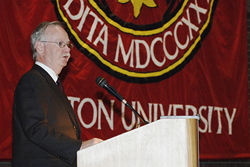Management Conference defines road ahead
Biosafety lab, branding, and core values fill agenda

Boston University executives met yesterday morning with more than 700 faculty and staff to outline some of the University’s largest and latest initiatives, such as the construction of the National Institutes of Health–funded National Emerging Infectious Disease Laboratories (NEIDL) in Boston’s South End. The 2006 Management Conference, held in Metcalf Hall, included a report on recent changes in the University’s marketing and communications department and a talk by President Robert Brown about the changing needs of the University.
Mark Klempner, Medical Campus associate provost for research and a MED professor, explained that the purpose of the $178 million Level 4 biosafety lab is to research diagnostics, vaccines, and treatments for dangerous infectious diseases, whether they occur naturally or are introduced through bioterrorism.
"We look forward to having the NEIDL play a vital role in finding cures for the many emerging infectious diseases that cause so much suffering around the world," Klempner said.
The planned lab has been met with protests from local activists, who have voiced concerns that an accident may endanger residents.
Gary Nicksa, the University’s vice president of operations, told the audience that after more than 240 community meetings, there is now “a growing level of comfort” with the facility. Nicksa, who likened the construction of NEIDL to “building a submarine inside of a bank vault,” assured the audience that the public is not at risk. “Everything going into the lab is monitored, inspected, and sealed behind double, air-tight doors,” he said. “Everything coming out will be sterilized or disinfected.”
Nicksa said that the NIH reviewed independent risk assessment reports about the NEIDL project and concluded that “the 21 different risk scenarios examined supported the conclusion that the facility poses negligible risk to the community.”
The construction grant of $128 million from the NIH’s National Institute of Allergies and Infectious Diseases requires that the building be substantially completed by June 30, 2008. The remaining $50 million construction cost will be paid by Boston University and Boston Medical Center. BU will own the building and be responsible for all the research conducted there.
In the second part of the program, Joel Seligman, assistant vice president of strategic communications, outlined the restructuring of the University’s marketing and communications department with an eye toward branding BU as a worldwide leading private urban research institution. The changes, under the leadership of Steve Burgay, vice president of marketing and communications, mark the beginning of an effort to “brand the University from the inside out,” Seligman said, beginning with students, faculty, and staff. While 2005 efforts focused on restructuring, he said, 2006 efforts will focus on execution, with the ultimate goal of creating a “sustained, consistent, and focused branding” of BU.
Brown, the gathering’s final speaker, expressed his support of the branding effort, and asked his managers to engage all University faculty, staff, and students in defining the University’s core values, not just at home, but also in the world at large. He emphasized that initiatives to increase fundraising are key to keeping the University on a fiscally disciplined path, since the school’s operating budget relies little on endowments. The president also pledged to “work tirelessly to increase the impact and stature of BU,” but warned that he couldn’t do it alone. He asked that all staff work together to develop a vision that will “stretch [the University] to meet new heights.”